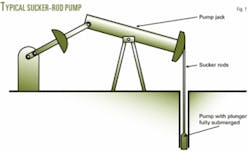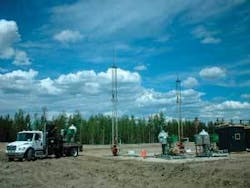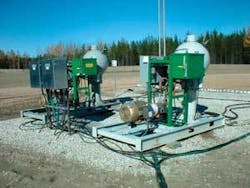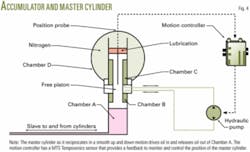A new pumping system installed on several wells in Canada allows production from wells previously classified as unproductive, as well as on new wells.
Ecoquip Artificial Lift Ltd., Calgary, designed the new pumping system.
The Ecoquip hydraulically driven rod pump, while suitable for new installations, can produce oil from wells that could not be pumped effectively with the older generation of rod pumps.
The new design allows the rods to reciprocate at varying speeds, thus improving pumping efficiency.
Oil well pumps
A typical oil well rod pump has a “bobbing donkey” design (Fig. 1). In the design, the rods typically move up and down at the same speed because of the mechanical linkage between the motor and the rod plunger. While constant-speed operations are adequate for applications where oil flows easily from the formation, it is not appropriate in many lower volume producing wells.
In these less productive wells, the key to improved pump performance is to provide various motion profiles to the pumping unit. For example, if the downhole conditions are such that the oil is viscous, the operator may want a faster upstroke to remove the oil but then have a slower downstroke to allow the oil to refill the tubing at the bottom of the well.
The old mechanical pumps do not easily allow for changing speed in mid-cycle; although, one can change the constant operating speed by changing a gear belt.
In the past, some operators have replaced mechanical pump jacks with hydraulically operated pump jacks, but these hydraulic units generally have allowed little flexibility in the pumping process.
New design
The new Ecoquip hydraulically operated rod pump allows adjustment of the pump-jack operating speed. The unit can change the speed on-the-fly to deal with short-term anomalies in the production.
Each pumping unit has two hydraulic slave cylinders, mounted vertically. The pump rods hang between them. When the cylinders extend, they pull the rods up during the suction stage. On the downstroke, the rod weight pulls the rods and hydraulic actuators down.
Fig. 2 shows two of the hydraulic rod pumps installed on Trident Exploration Corp. wells near Swann Hills, Alta. Next to the rod pumps are the set of pumps, valves, and hydraulic accumulators that provide the power. Fig. 3 is a closer view of the control and pumping equipment.
Each sphere is an accumulator. Under each accumulator is a large hydraulic master cylinder that forces oil into the slave cylinders that lift the rods.
Fig. 4 shows a cutaway view of the accumulator and master cylinder beneath. During the pumping cycle, as the weight of the rods in the well pulls the rods down, they force oil back into the master piston. The oil pressurizes the nitrogen in the sphere for assisting the next upstroke.
The accumulator contains nitrogen under pressure and serves as a counter balance storing energy during the down stroke to balance the weight of the pump rods.
Because the accumulator contributes to balance the weight of the pump rods, the system requires a smaller 80-100 hp hydraulic pump than would be needed if the hydraulics provided all the lifting force for the rods. The rod and its payload of produced fluid typically weighs 27,000-35,000 lb.
Hence, the accumulator accommodates a wide load range with the same power unit.
Most installations to date are on wells with a 1,000-7,000 ft depth. The average well depth is about 4,000 ft.
A typical installation has the following capacity:
- A 2.75-in. diameter sucker-rod pump at 6 strokes/min will lift a 144-in. column of fluid/stroke. At 85% pump efficiency, the pump will lift about 648 b/d of fluid.
- A 1.5-in. diameter sucker-rod pump at 6 strokes/min will lift a 144-in. column of fluid/stroke. At 85% pump efficiency, the pump will lift about 193 b/d of fluid.
Note that the stroke rates can range from 2 to 6/min, depending on well conditions.
The master cylinder below the sphere and the slave cylinders that lift the pump rods are hydraulically linked to each other. As the master cylinder moves, the slave cylinders move. Because of the difference in cylinder diameters, when the master has a 1-in. movement, the slave moves 6 in.
The main hydraulic pump providing fluid to the system is a swashplate model manufactured by Sundstrand Corp. When the pump swashes in one direction, it moves the master cylinder one way to cause the lifting cylinders to raise the rods. When it swashes in the other direction, the rods come down.
As the rods come down, the pump assists in pressurizing the nitrogen in the sphere to help the lift on the next upstroke.
A proportional hydraulic servo valve, controlled by an electrohydraulic motion controller, drives the swash plate. A small gear-driven pump maintains pilot pressure to operate the valve.
This is the first time that swash-plate hydraulic pumps have been used in rod pumping applications. Also the use of a spherical pressure-charged accumulator to balance the weight of the rod is a new innovation.
Motion controller
The motion controller, recommended by PQ Systems, is the RMC75E, manufactured by Delta Computer Systems Inc., Vancouver, Wash. Position feedback from a MTS System Corp., Cary, NC, Temposonic absolute position probe mounted on the master cylinder feeds into the RMC75 motion controller. The controller sends the correct signal to the servo valve that drives the pump, thereby providing more flow or less flow to achieve the desired cylinder speed and position.
Using feedback from the position sensor, the motion controller can control the upward and downward speeds of the slave cylinders independently, as well as stop and start the slave cylinders and adjust the stroke length.
The programmability of the motion controller allows the operator to develop sophisticated pumping recipes to produce as much oil as possible from the well.
PQ Systems also supplied a touchscreen operator interface that enables the speed up, speed down, and stroke length to be changed at the touch of a button.
The Delta RMC motion controller also can connect to hydraulic pressure sensors. The pressure information allows the controller to monitor the loads on the system, which can indicate downhole conditions. Using this information, the Delta controller can change the pumping speed to accommodate changes in well conditions.
For example, if a pocket of gas enters the oil, the load will get spongy. When the motion controller detects that, it will tell the pump jack to slow down until the gas clears. Such dynamic flexibility is impossible with the old purely mechanical pumps or even hydraulic pumps without programmable closed-loop control systems.
The RMC also provides information such as strokes/minute and hydraulic pressure, which reflects the loads in the well. Delta’s software can graph these parameters to yield a visual picture of events downhole.
The RMC75E comes with an Ethernet interface, which connects the motion controller to the touchscreen operator interface. Ultimately, PQ Systems desires to use that interface to add wireless satellite communications to the pumping stations. This would enable remote monitoring and uploading of program instructions from anywhere in the world, a highly desirable feature for pumping stations in the frozen North or other remote locations.
The RMC75E model that Ecoquip uses also provides digital inputs and outputs that enable the motion controller to act as a programmable logic controller (PLC), monitoring other functions in the pumping system. For example, the motion controller can monitor the temperature of the pump, cooling fans, and hydraulic oil, as well as the system alarms.
Wireless communications added to the system will allow the pump jack to send an alarm via the wireless network.
Installation of the Ecoquip system typically takes 3-4 hr.
Current installations
Companies have installed about 50 of the new rod pumps to date. In Alberta, Trident Exploration Corp. has several pumps installed in their operations near Swann Hills. Other units are in ConocoPhillips operations near Big Valley and Duvernay Oil Corp. operations near Hinton.
One unit also is in operation near Fort St. John, BC.
The authors
Bill Savela is the motion products marketing manager for Delta Computer Systems Inc, Vancouver, Wash. He has more than 20 years of industrial process and motion control experience in applications engineering, marketing, and sales. Savela has a BS in electrical engineering and an MS in business administration from Michigan Technological University. He is a registered professional engineer.
Chris Bartlett is an applications and sales engineer for PQ Systems Ltd., North Burnaby, BC. He primarily works on closed-loop control systems with proportional servo drives, motion controllers, and feedbacks. Previously he worked for Rexroth Europe, developing proportional and servo applications.





